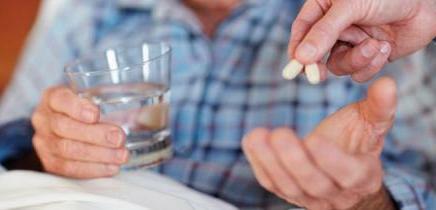Osteoporosis is a chronic systemic progressive disease that affects bone tissue.
The consequence of this disease is a decrease in bone density, which increases the risk of a fracture from a simple fall or bruise.
Bone tissue, like any other, is constantly updated. When bone loss with osteoporosis, the process of tissue renewal is disrupted, that is, cells are destroyed faster than new ones, due to which the mass of bone tissue is reduced, and in it are formed pores-emptiness.
It is impossible to say that these are only irreversible processes of organism aging. With age, the strength of bone tissue really decreases, but with osteoporosis this happens much faster and more intensively.
The World Health Organization reports that osteoporosis is epidemic and is the fourth most frequent cause of disability and mortality. In this list, osteoporosis is second only to oncology, diabetes and heart failure.
Content
- 1Zone of risk of osteoporosis
- 2Proper nutrition with osteoporosis
-
3Calcium diet
- 3.0.1What should not be done with a calcium diet?
Zone of risk of osteoporosis
The danger of the disease with osteoporosis lies in its asymptomatic nature of leakage. That is, a person learns about his diagnosis when a fracture has already occurred.
Risk factors:
- Asian and Caucasoid races;
- age over 65;
- Subtle (fragile) physique;
- alcohol and smoking;
- early menopause;
- women & g; 72cm, male & g; 83 cm;
- sedentary lifestyle;
- transferred infectious diseases;
- use of anticonvulsants;
- intolerance to dairy products;
- malnutrition (deficiency of calcium and vitamin D).
Since osteoporosis is an irreversible process, it is important to talk about the timely prevention of this disease.
The best warning of this ailment will be a full-fledged diet.
Proper nutrition with osteoporosis
The main and most important carrier of calcium in the human body is bile. In a healthy body, a day and a half liters of this substance is produced per day. It helps the intestines absorb the calcium that comes with food.
Often a person in his diet uses foods with sufficient calcium, but he does not digest, which a person does not even suspect. It turns out that the reason for this is an insufficient amount of bile produced. Therefore, in case of osteoporosis, you should closely monitor the consumed foods and adhere to proper nutrition, taking food 5 times a day.
General rules of nutrition in osteoporosis:
- Limit the intake of foods that promote the excretion of calcium from the body. These include beverages that contain caffeine, such as cocoa, coffee, strong tea (especially green), and chocolate.
- Avoid foods saturated with fatty acids, since both calcium and fats are digested with one substance - bile. While it will help the body absorb fatty acids, the element will be removed from the body. To such food carry oil, margarine, mayonnaise.
- Sesame, cheese, sour cream and eggs are the source of vitamin D, which is necessary for this diet. These foods should be included in your diet.
- Do not get involved in meat dishes. Excess phosphorus in the body interferes with calcium absorption. But you can not completely exclude meat from your menu, since only in balance with magnesium and phosphorus calcium is well absorbed.
- Do not drink alcohol, as well as diuretics and carbonated drinks.
- Useful for the body will be foods containing folic acid and vitamin B6. These include legumes and cereals, beef liver and various seafood.
- In osteoporosis, the body especially needs zinc. The need for this micronutrient increases many times. Zinc is rich: chicken hearts, sunflower seeds, peanuts, pine nuts, shrimp, sea kale, cheeses and soy.
- Magnesium is also an important microelement for maintaining human health. A sufficient amount of magnesium is found in peas, beans, oatmeal, walnuts, mustard and buckwheat.
Calcium diet
Calcium diet is a reasonable solution both with a tendency to develop osteoporosis, and a measure of preventing calcium deficiency in the body of a woman during pregnancy and during lactation. This micronutrient is also necessary for children and anyone who engages in heavy physical labor.
Sometimes this diet is prescribed after dental procedures and even with certain heart diseases. In this case, we are interested in the role of the calcium diet in preventing osteoporosis.
Basics of calcium diet:
- the use of vegetables and fruits (they contain potassium, which prevents the excretion of calcium from the body);
- inclusion in the menu of a sufficient amount of protein food;
- reduced intake of foods that interfere with the absorption of calcium;
- daily consumption of water liter.
The main principle of the calcium diet is eating foods containing a large amount of calcium:
- milk and sour-milk products: cottage cheese, kefir, fermented baked milk, cheese, sour cream;
- soy and soy products, tofu will also be useful;
- seafood (shrimp), fish and even canned fish (sardines in oil);
- a lot of calcium is in some vegetables, such as lettuce, celery, olives and some cabbage (broccoli);
- dried fruits, pumpkin seeds, nuts;
- rice, semolina porridge;
- natural ice cream.
What should not be done with a calcium diet?
On a diet with osteoporosis, it is desirable to exclude and significantly reduce the amount of salt and refined sugar.
And harmless at first glance, spinach and sorrel is better to exclude at all, they also interfere with the absorption of calcium in the body.
Rice is useful in osteoporosis, but only in moderation
For example, rice in reasonable quantities contains a lot of calcium absorbed by the body, but if you greatly increase the portion of rice, you will get the opposite result.
The same applies to all cereals and legumes: cereals, beans, peas, peanuts, bread and bran.
In small quantities, these products will benefit. When abused, they will begin to interfere with calcium absorption.
It is important to understand that treatment can not be based solely on taking one micronutrient in large doses. In order to bones, teeth and nails were strong, you should eat foods that do not contain only calcium, but also magnesium, phosphorus, zinc, copper and other elements involved in maintaining health rights.



